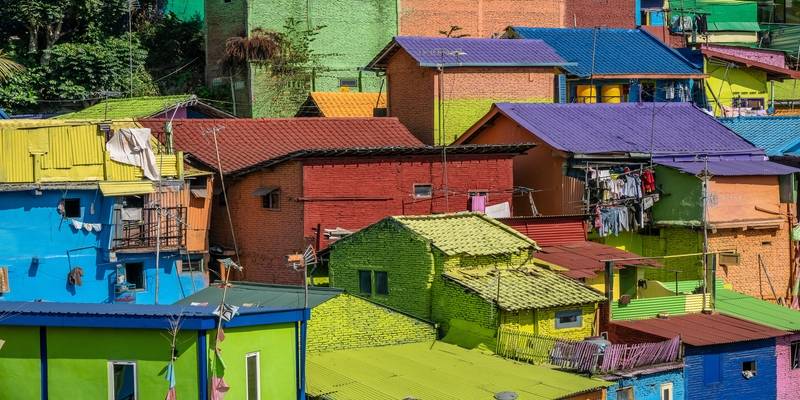Slum tourism: walking through the shanties of the world

Long ago, I heard the famous quote by director Tim Burton: “One person’s craziness is another person’s reality”, and I briefly forgot about it. But while booking one of my travel packages, I came across slum tourism, and the quote came back and hit me in the face. True, the life we can only imagine to be a crazy, rough, or tough road is the one that someone is living every day. But how ethical and logical does it sound to encash on it — for entertainment? That’s truly beyond me.
We humans have a way of finding different means to satiate our quest to know the unknown, to experience far-fetched realities, and to fulfil our undying thirst to feel more blessed than others — or maybe, superior. I believe all of this comes together really well in a well-planned slum tour. No wonder this type of tourism’s popularity across the globe is growing substantially.
Travel agencies are rampantly pushing out tours to shanty towns to acquaint the blessed and wealthy with the poverty-laden lives of the people there. At what cost, I ask? While some may argue it has its own benefits, it can’t be denied that it comes with its issues. So, I decided to dig deeper. And here I am, presenting all that I have learned about this fad in this feature.
Read along and ask yourself: how good or problematic is this trend?
What exactly is slum tourism?
When we think of tourist destinations, we often swoon over pristine beaches, historical museums, pleasant mountains, or fascinating concrete jungles. However, the paradigm is shifting, and now slums across the globe are gaining popularity as tourist attractions. These zones, which are often considered filthy, unsafe, and no-go areas, are now brimming with tourists. Be it Dharavi in India, Soweto in South Africa, or Manila in the Philippines, the status quo remains the same.
Slum tourism entails organised tours to shanty towns, where a gazillion tents and temporary houses line the sides of railway tracks and rivers or are spread over a huge area visible from the posh city’s airport, like Dharavi. These tours allow tourists a sneak peek into the lives of the dwellers in the area. By showcasing their daily living, struggles, and community life, these tours aim to sensitise the affluent to the lives of the less fortunate. With untreated sewage, undisposed trash, non-functional water pipes, bare minimum means of survival, and people with heavy hearts yet smiling faces, these tours often shine a light on the neglect that the marginalised experience at the hands of the government.
Apart from showcasing the regular ways of living, many slum tours attempt to show a silver lining. They take visitors to various upliftment projects in the area, be it schools, washrooms, orphanages, or upcoming waste treatment facilities. The idea is always to bring tourists to terms with reality and highlight what’s being done to make it better.
Where did it all begin?
Technically speaking, it is not a novel phenomenon and has been around for centuries. For instance, in the 19th century, upper-class people from London visited the East End to look at the poor. At that time, this practice was commonly called ‘slumming’. The British then carried this practice to the other end of the world: New York and San Francisco.
Here, they would visit the ghettos and compare the poverty situation there to back home. As a matter of fact, looking at the ethical connotation of this mockery, San Francisco banned the practice in 1909. However, this practice slowly spread from here on. A major boom came in when the world started to pay attention to the anti-apartheid movement in South Africa. That is when Soweto and Cape Town became hubs of slum tourism.
As of today, whether you call it a trip to a slum, a favela, a barrio, or a ghetto, this form of tourism is peaking, in all its glory, all across the globe.
The good, bad, and the ugly
This form of tourism has been under the moral lens for a long time. While some may argue that these tours help us come in touch with the reality of many, others are not too sure if this is the right way to do so. Even though this has been a debatable topic, its popularity continues to rise, despite the constant backlash. So, let’s delve deeper to understand the two sides of this coin.
The discomfort and ethical dilemma around slum tourism are undeniable. However, many argue that it is sure to uplift society and its benefits can’t be ignored. Advocates for slum tourism suggest that it provides an excellent opportunity to spread awareness. More often than not, for many people, these tours are the first exposure to the stark realities of poverty.
The visceral experience of walking through narrow, overcrowded lanes and seeing the sheer resilience of slum dwellers has the potential to ignite a sense of empathy and a desire to help. These advocates also suggest that understanding the hardships that the dwellers face daily can encourage meaningful actions. These include actions such as donations, volunteering, or supporting policy changes.
The supporters of slum tourism also say that these tours form a part of livelihood for many dwellers. Local guides to these tours often hail from these communities. They earn a living by showing visitors around and sharing their life stories. Many tour organisers also direct a part of the fee towards the development and upliftment of the communities. They do so by either providing money or by providing resources for education, sanitation, and healthcare facilities.
Lastly, many people also believe that these slum tours shine a light on the fact that these places are more than just poverty-laden communities. For instance, walking down the streets of Dharavi will tell you that it’s not merely a slum but a huge market for leather. Many families here produce leather products that are sold in the market. Also, these tours help us realise the value of community living and togetherness in times of stress.
On the other hand, could you imagine a group of people walking by your house, gawking at what you’re doing and how you do it within your means? Can you imagine random strangers trying to talk to you every second day to understand your lifestyle and your struggles? Does it sound invasive to you? Would it not feel invasive to them? It’s something we all need to ponder about; only after we keep our crown of privileges aside.
Critics often argue against slum tourism due to the fact that it exploits the misery of the underprivileged for the amusement of the affluent, in turn reinforcing stereotypes. As many across the globe are trying hard to fight the root cause of poverty, slum tourism risks turning human suffering into a spectacle. That’s not entirely wrong. Afterall, the power dynamics between tourists and locals is extremely unequal and it just ends up exacerbating the issue. While tourists might see the slum dwellers as subjects of curiosity or sources of inspiration, the locals may feel objectified, as though their struggles are being commodified for someone else’s gain.
Moreover, the funds generated from slum tours don’t always trickle down to the community. In many cases, tour operators and private companies pocket most of the profits, leaving the slum dwellers with little to no benefits. This raises a critical question: who truly gains from slum tourism, and at whose expense?
Where do we go from here?
As slum tourism continues to grow in popularity, one should stop and think about our roles as tourists and individuals. Are we okay with being mere spectators as we exploit others? Or do we really have it in us to become catalysts of change? If done ethically, slum tourism can spark conversations that hold the power to bring meaningful change. But for that, the focus needs to shift from voyeurism to empowerment.
At its core, the question remains: would you open your doors to let the world observe your life, not knowing whether they’re there to understand, judge, or to simply walk away?






